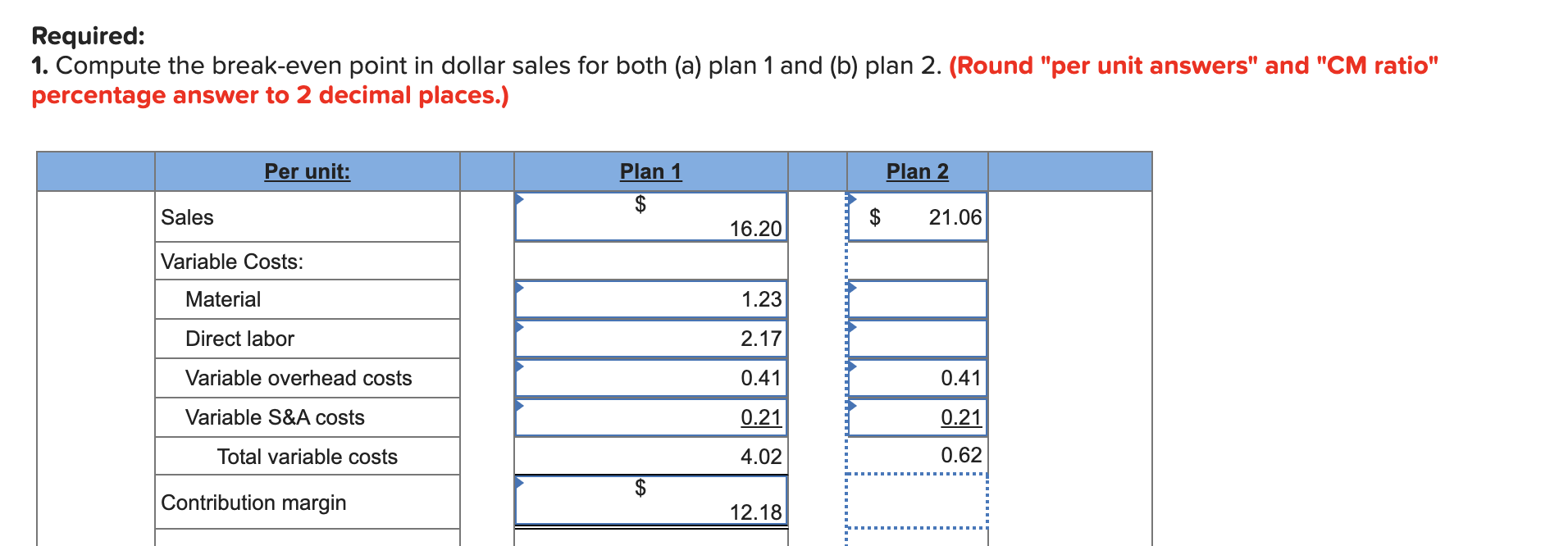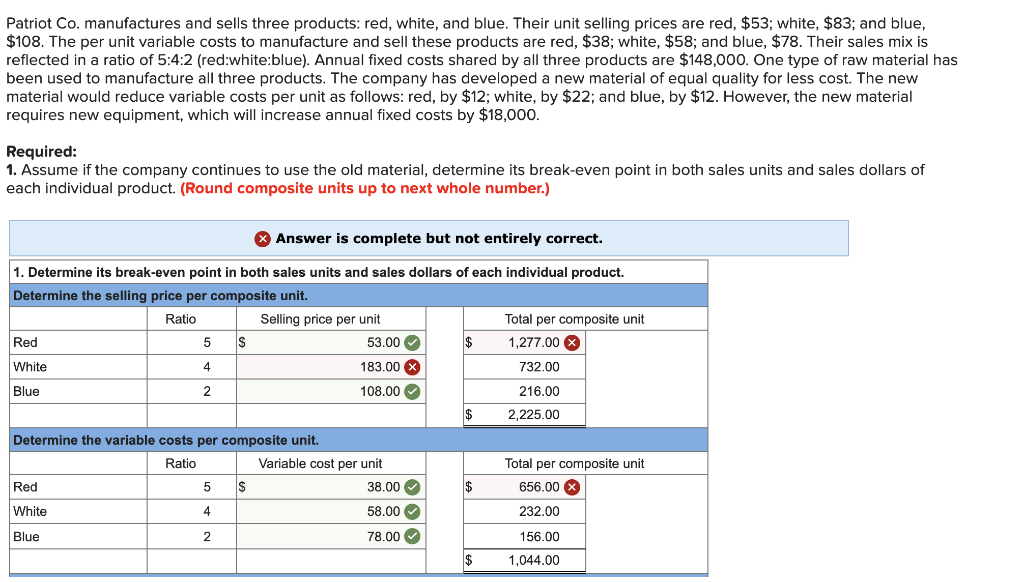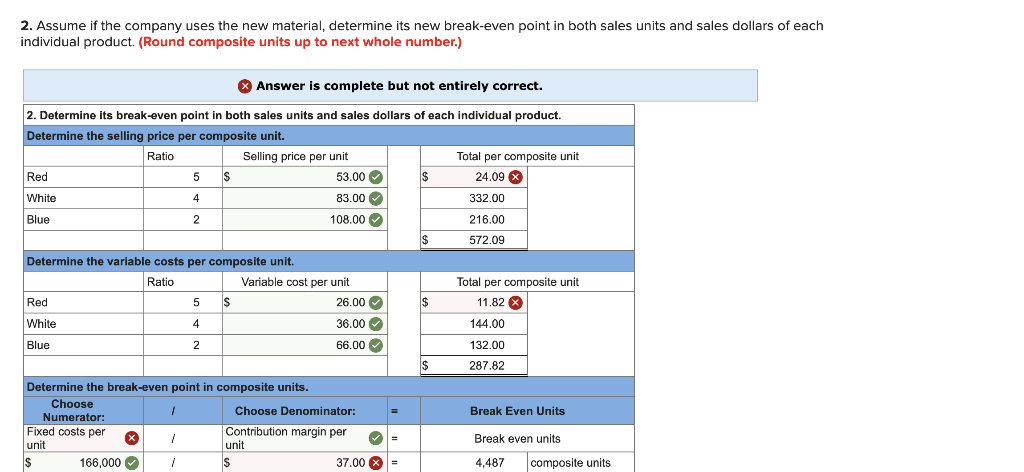Answered step by step
Verified Expert Solution
Question
1 Approved Answer
please see the below for Question 1: Compute the break event amount I filled in as much as I can, but the answer showed incorrect
please see the below for Question 1: Compute the break event amount I filled in as much as I can, but the answer showed incorrect for PLAN 2 Direct materials, direct labor and contribution margin.
Also see the other incorrect answer highlighted in red with an X.




! Required information (The following information applies to the questions displayed below.] This year Burchard Company sold 36,000 units of its only product for $16.20 per unit. Manufacturing and selling the product required $121,000 of fixed manufacturing costs and $181,000 of fixed selling and administrative costs. Its per unit variable costs follow. Material Direct labor (paid on the basis of completed units) Variable overhead costs Variable selling and administrative costs $4.10 3.10 0.41 0.21 Next year the company will use new material, which will reduce material costs by 70% and direct labor costs by 30% and will not affect product quality or marketability. Management is considering an increase in the unit selling price to reduce the number of units sold because the factory's output is nearing its annual output capacity of 41,000 units. Two plans are being considered. Under plan 1, the company will keep the selling price at the current level and sell the same volume as last year. This plan will increase income because of the reduced costs from using the new material. Under plan 2, the company will increase the selling price by 30%. This plan will decrease unit sales volume by 15%. Under both plans 1 and 2, the total fixed costs and the variable costs per unit for overhead and for selling and administrative costs will remain the same. Required: 1. Compute the break-even point in dollar sales for both (a) plan 1 and (b) plan 2. (Round "per unit answers" and "CM ratio" percentage answer to 2 decimal places.) Per unit: Plan 2 Plan 1 $ Sales $ 21.06 16.20 Variable Costs: Material 1.23 Direct labor 2.17 Variable overhead costs 0.41 0.41 Variable S&A costs 0.21 0.21 Total variable costs 4.02 0.62 Contribution margin 12.18 Patriot Co. manufactures and sells three products: red, white, and blue. Their unit selling prices are red, $53; white, $83; and blue, $108. The per unit variable costs to manufacture and sell these products are red, $38, white, $58; and blue, $78. Their sales mix is reflected in a ratio of 5:4:2 (red:white:blue). Annual fixed costs shared by all three products are $148,000. One type of raw material has been used to manufacture all three products. The company has developed a new material of equal quality for less cost. The new material would reduce variable costs per unit as follows: red, by $12; white, by $22; and blue, by $12. However, the new material requires new equipment, which will increase annual fixed costs by $18,000. Required: 1. Assume if the company continues to use the old material, determine its break-even point in both sales units and sales dollars of each individual product. (Round composite units up to next whole number.) Answer is complete but not entirely correct. 1. Determine its break-even point in both sales units and sales dollars of each individual product. Determine the selling price per composite unit. Ratio Selling price per unit Total per composite unit Red 5 S 53.00 $ 1,277.00 X White 4 183.00 X 732.00 Blue 2 108.00 216.00 $ 2,225.00 Determine the variable costs per composite unit. Ratio Variable cost per unit Red 5 $ 38.00 White 4 58.00 Total per composite unit 656.00 X 232.00 Blue 2 78.00 156.00 1,044.00 2. Assume if the company uses the new material, determine its new break-even point in both sales units and sales dollars of each individual product. (Round composite units up to next whole number.) Answer is complete but not entirely correct. 2. Determine its break-even point in both sales units and sales dollars of each individual product. Determine the selling price per composite unit. Ratio Selling price per unit Total per composite unit Red 5 S 53.00 S 24.09 White 4 83.00 332.00 Blue 2 108.00 216.00 IS 572.09 Determine the variable costs per composite unit. Ratio Variable cost per unit Total per composite unit Red 5 S 26.00 $ 11.82 X White 4 36.00 144.00 Blue 2 66.00 132.00 $ 287.82 = Break Even Units Determine the break-even point in composite units. Choose Choose Denominator: Numerator: Fixed costs per Contribution margin per X 1 unit unit $ 166,000 1 S 37.00 X = Break even units 4,487 composite units Determine its break-even point in units and sales dollars of each individual product. Number Units sales at per Number of composite units the break-even composite to break even. unit point Dollar sales at the break-even point Red 5 4,487 53 108,067 White 4 4,487 17,948 1,489,684 969,192 Blue 2 4,487 8,974
Step by Step Solution
There are 3 Steps involved in it
Step: 1

Get Instant Access to Expert-Tailored Solutions
See step-by-step solutions with expert insights and AI powered tools for academic success
Step: 2

Step: 3

Ace Your Homework with AI
Get the answers you need in no time with our AI-driven, step-by-step assistance
Get Started


